
NEW ONLINE POULTRY CATALOG
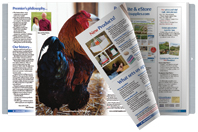
New! "Poultry Catalog Digital Flip-book" on our website
Now you can read our catalog online! Our "catalog flip-book" is linked for easy transition from catalog to eStore.
Print individual pages or download to your desktop.
NEW FROM PREMIER
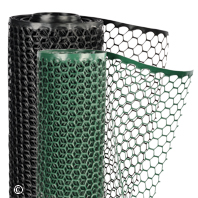
NoShock Chick Fence
| • |
Nonelectrified |
| • |
Easy to install |
| • |
Plastic mesh, 3/4" openings |
| • |
4 ft tall x 50 ft long |
| • |
Green or black |
Why NoShock Chick Fence?
Chicks and ducklings are too small to be contained by PoultryNet™. Why? The spacings at the bottom of the net are large enough for them to slip through, and the chicks not heavy enough to make a good electrical connection to deter them.
That's why we're introducing a tighter, nonelectrifiable alternative to PoultryNet™ with "chick-stop" openings to keep in chicks, ducklings and other small birds.
NoShock can also be used to keep free-range birds out of flower beds, gardens and patios and away from roadways.
How to use...
NoShock can be used either as permanent or temporary fencing.
| • |
NetPost 15's can be woven through the mesh every 10 ft for a temporary fence. |
| • |
Can be stapled or zip-tied to wood or metal posts for a permanent poultry run. |
When you set up NoShock Chick Fence and move your birds outdoors, use this time to upgrade to larger feeders and waterers. As the birds grow, they will need equipment with larger capacities to accommodate their increased appetites. If the feeders are to be outdoors, be sure to get one with a rain hat that will keep the feed dry.
If you're raising waterfowl, include a SureFoot Foot Bath so your ducks or geese can enjoy a small "pond." For young birds, you may need to make temporary "steps" (a pile of rocks) so they can get in and out of the bath.
To determine your specific needs, view our feeder and waterer comparison charts.
FENCE SOLUTIONS FOR POULTRY, DUCKS & GEESE
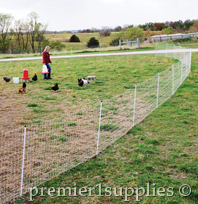
What is poultry netting?
An electrifiable, prefabricated, portable fence. Arrives as a complete fence (except for an energizer and lightweight corner posts) with line posts built into each roll.
Why is it so popular?
| • |
Keeps in adult poultry. |
| • |
Keeps out 4-footed predators like dogs, coyotes, raccoons, skunks, foxes, opossums and bears (when energized). |
| • |
Much easier and faster than other fences to install, adjust, relocate and remove. Takes less than 10 minutes to install a roll. See our "How-to" video. |
| • |
Can be installed by one person, but handling the longer rolls is easier with 2 people. |
| • |
Flexible. Unlike permanent fences, netting is easy to set up around corners and curves — and over dips and hills. |
| • |
No tools required. Only hand-tensioning is needed — which enables it to adapt easily to curves, hills and corners. |
Which is the best height?
While both heights stop most poultry, 48" net is perceived as more secure against coyotes and dogs.
However, the shorter 42" net is lighter and easier to handle when installing and removing. It's also less expensive.
See also feeders and waterers that can be used outdoors alongside our PoultryNet.
|
 |
 |
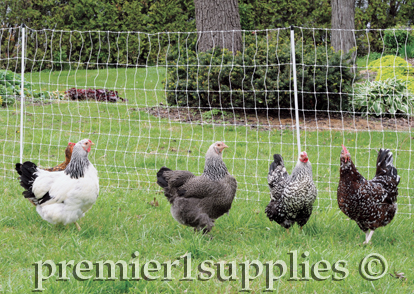
Get excited, poultry fans! Free the chickens from the confines of their coop.
Now that the sun is shining and the grass is green, it's time to plan your chicken runs/pens for the coming "grazing" season.
Some poultry keepers even put them to work in the garden (before it's planted) to stir up the stalks and add fertilizer.
Try PoultryNet™ for the chicks you hatched earlier this spring. If they are still on the smaller side, set up a roll of NoShock Chick Fence protected by a roll of PoultryNet to keep predators away.
VIP ARTICLE
Managing Poultry on Pasture with PoultryNet/PermaNet
(copyright by Harvey Ussery and reprinted with his permission)
We keepers of the home flock are often advised not to keep our birds all cooped up: "Get 'em out into the fresh air and sunshine!" But we know the local tribe of predators like our poultry as much as we do, so we take care to install a good stout fence around our chicken run to keep out the bad guys. Now it's safe to let the flock out into their little corner of the great outdoors. But wait! Within a week every last blade of grass is gone from the run — it looks like the surface of the moon dotted with chicken poops! Droppings are accumulating, flies are having a field day, pathogens are a potential hazard, and the run is a source of run-off pollution with every heavy rain. A static chicken run is not such a good idea!
Much better to release those birds, let 'em free-range like nature intended! Now they're healthier and more content; and the live foods they forage — green growing plants, wild seeds, earthworms, slugs, and insects — are of a quality we cannot hope to match with anything from a bag. The living pasture sod "digests" the poops laid down — vastly healthier for the flock than the static run (and a boost in fertility for the pasture). This is the life for "the natural chicken"! Oh but wait, they're in the garden! And Mr. Pumphrey's rose bed! And worst of all, Brer Fox and Mr. Raccoon are having a field day (to say nothing of the neighbors' dogs)! Free-ranging the flock is a terrible idea!
Is there any way to manage the homestead flock that both gives them access to the many benefits of free-ranging on good pasture, confines them where we want them, and protects them from the bad guys? Fortunately there is: electric net fencing, or electronet.
(Note: The Electronet referred to in the article is Premier's PoultryNet™.)
READ MORE »
Harvey Ussery is the author of The Small-Scale Poultry Flock (Chelsea Green, 2011), on sale in Premier's book section. Visit Harvey's website at www.themodernhomestead.us
PREMIER TIP
"How many square feet of space do I need for my chickens?"
The answer depends on several factors, including size of birds and whether they are free-range or confined or a bit of both. Our chickens (about 50) enjoy being outside during the pleasant days of spring, summer and fall, but when the weather is chilly, windy or wet, they tend to stay inside by choice. On those days they need additional space inside even though we consider them to be free-range.
The following are standard space guidelines.
It's fine to add more space for your birds if you have it available.
For each free-range bird:
| • |
Heavy breeds — 4 sq ft. If birds are to be butchered before 16 weeks of age, 2 sq feet will work. |
| • |
Light breeds — 3 sq ft |
| • |
Bantams — 2 sq ft |
For each bird in confined housing:
| • |
Heavy breeds — 10 sq ft |
| • |
Light breeds — 7.5 sq ft |
| • |
Bantams — 5 sq ft |
Other interesting bird facts —
Incubation time:
| • |
Chickens — 21 days |
| • |
Ducks — 28 days |
| • |
Geese — 28 to 32 days |
| • |
Pheasants — 24 to 28 days |
| • |
Turkeys — 28 days |
Life expectancy:
| • |
Chickens — 5 to 9 years |
| • |
Ducks — 6 to 8 years |
| • |
Geese — 10 to 20 years |
| • |
Quail — 1 to 2 years |
HOW-TO
Clipping Flight Feathers
Disclaimer: Most birds live and range contentedly within their allotted area. Only select few birds feel the need to "fly the coop." At Premier, we're fortunate to have enough space to give our birds room to roam safely within our netting, so we've never needed to clip any wings.
"How do I keep my flighty poultry from flying over the electrified PoultryNet™?"
Answer: Clip their wing feathers.
Most birds, when given enough space, feed and water, will stay within netting. But some birds are more likely to fly than others. Heavy breeds like White Rocks can't get off the ground as easily as light layer breeds, such as Leghorns. Some bantam breeds can and do fly up and over netting. Roosters have incentive to fly if the hens are nearby or when feuding with each other. Startled chickens (from barking dogs, loud traffic, noisy lawnmowers) are also more inclined to fly. Young chickens tend to fly more frequently than older ones.
For those birds that suspect the grass is greener on the other side of the fence, clip flight feathers on one wing to remove the balance needed for flight. The feathers will grow back with the next molt. Feather regrowth may be quicker with young birds than for aged birds.
The process, which involves only trimming the feathers along the primary feather line, does not hurt or injure the bird when done correctly. The primary feathers are normally tucked under the wing, and you have to extend the wing to see them. They are normally a different color and easy to locate.
Trim only one wing, not both. (Clipping both wings will allow the birds to reclaim some of the balance they need for flight.) Use sharp scissors; hoof trimmers will also work.
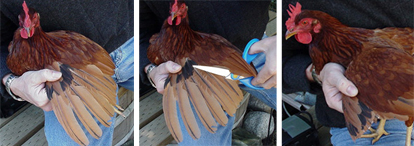 How to clip flight feathers. Photos courtesy of backyardchickens.com.
How to clip flight feathers. Photos courtesy of backyardchickens.com.
To clip the feathers:
| 1. |
Restrain the bird in one hand or have someone hold it for you. |
| 2. |
Select a wing and pull it out to expose all the feathers. The longest feathers on the tip of the wing are the primary feathers — there should be 10 of them. |
| 3. |
With scissors, start trimming the primary feathers at the point where the secondary feathers meet the primary ones. |
| 4. |
Continue trimming the primary feathers along the edge. See photos above for reference. |
|
|